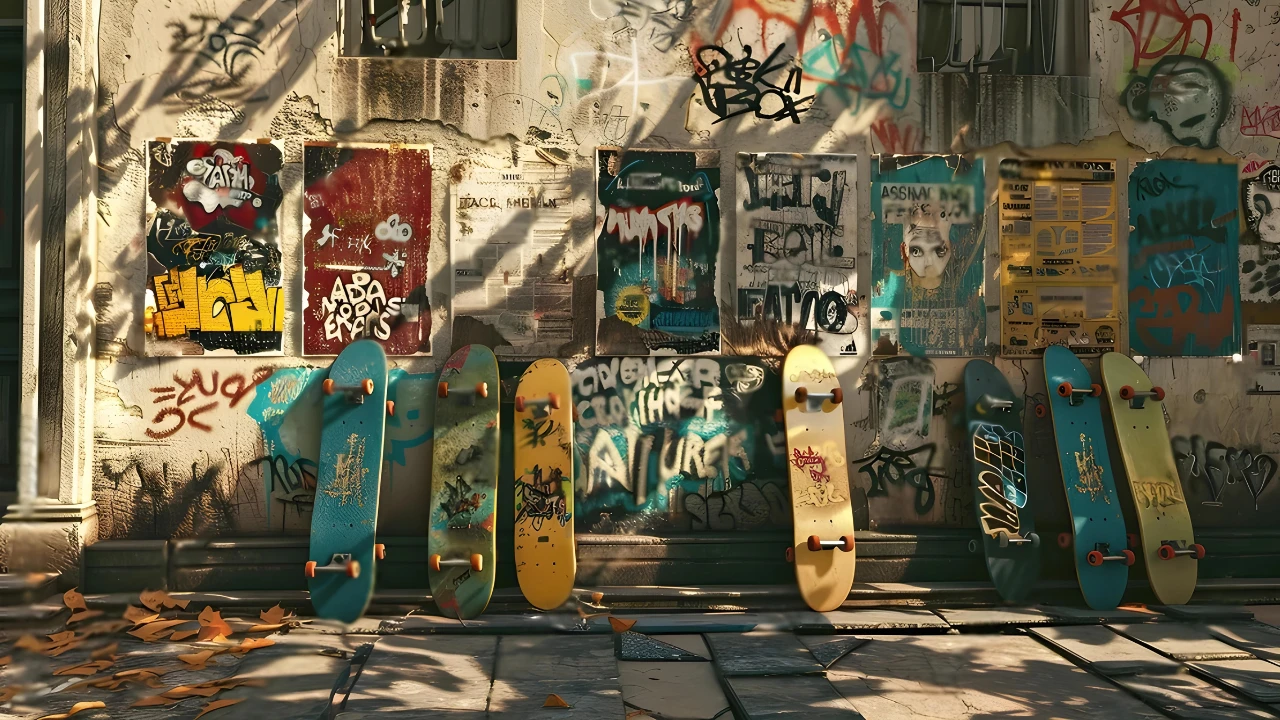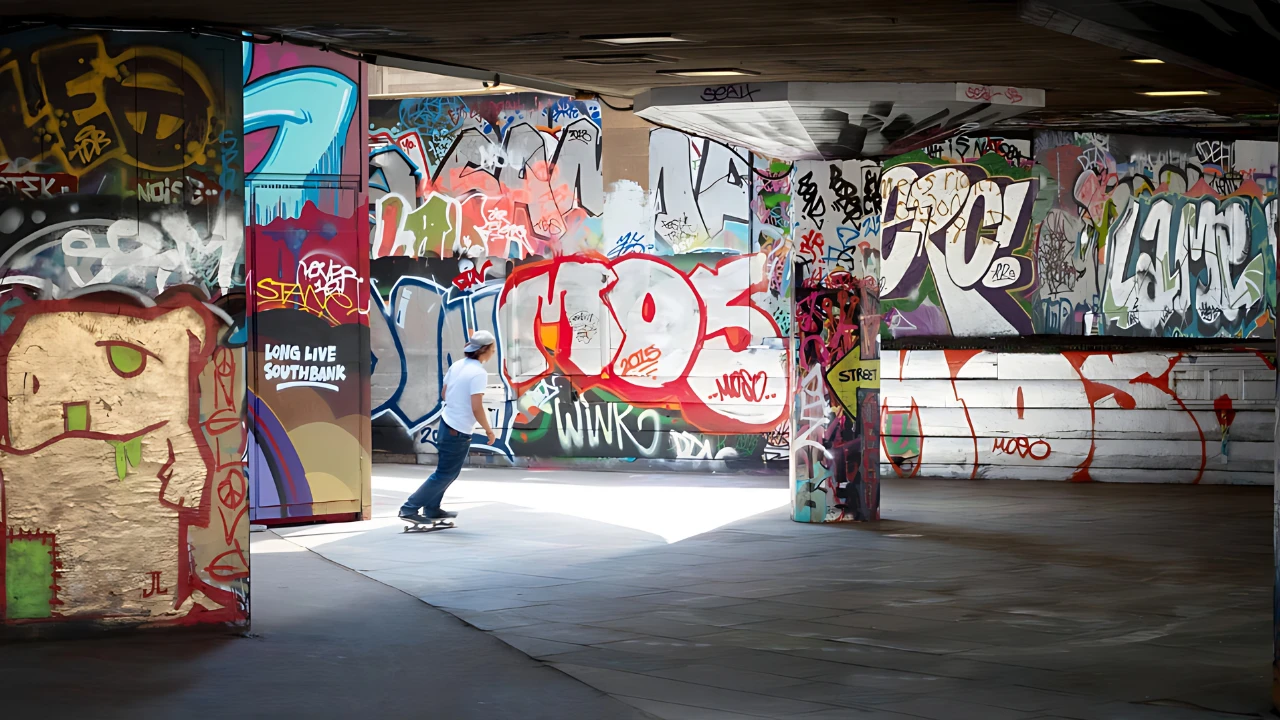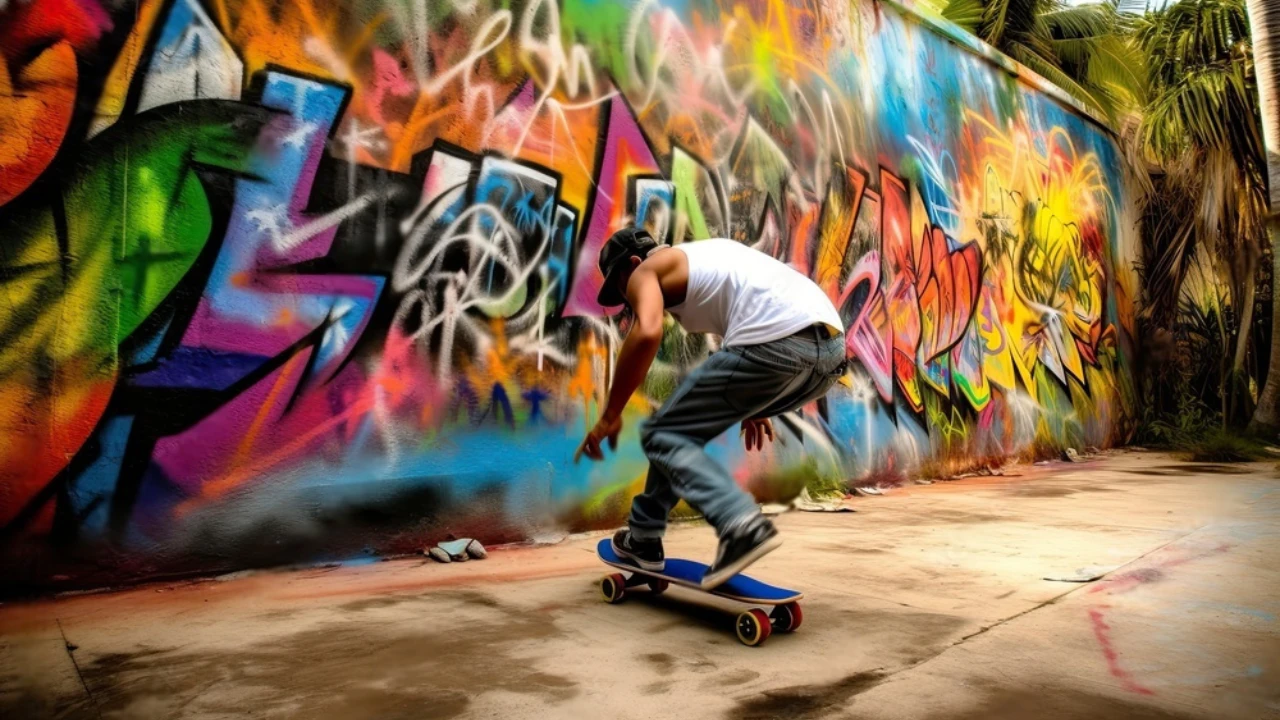In recent years, skateboarding has transcended its status as a mere sport or recreational activity to become a powerful catalyst for artistic expression and cultural innovation. From the vibrant graphics adorning skateboard decks to the dynamic movements of skateboarders navigating urban landscapes, skateboarding has emerged as a dynamic and influential force within the art world.
In this comprehensive article, we delve into the fascinating relationship between skateboarding and the art world, exploring how this dynamic subculture has inspired creativity, challenged conventions, and shaped contemporary art practices. Join us as we uncover skateboarding’s multifaceted role in the art world and celebrate the unique fusion of athleticism, aesthetics, and creativity that defines this vibrant cultural phenomenon.
Key Takeaways:
- Creative Fusion: Skateboarding blends athleticism and aesthetics, acting as a catalyst for artistic expression.
- Urban Inspiration: Skaters navigating urban landscapes inspire dynamic movements and innovative art practices.
- Impact on Contemporary Art: Skateboarding challenges conventions and fosters creativity, shaping contemporary art practices.
- Influence on Skateboarding Culture: Integrating skateboarding into the art world elevates aesthetic appreciation, provides cultural validation, and encourages collaboration and exchange.
Table of Contents
The History of the Role of Skateboarding in the Art World
Skateboarding’s influence on the art world is a dynamic and multifaceted relationship that has evolved over several decades. From its humble beginnings as a subculture rooted in rebellion and creativity to its current status as a mainstream phenomenon, skateboarding has left an indelible mark on artistic expression across various mediums.

1. Origins in Subculture (1950s-1970s):
Skateboarding emerged in the 1950s as a recreational activity among surfers looking for ways to ride the streets when waves were flat. By the 1970s, skateboarding had evolved into its own subculture, characterized by DIY ethos, urban exploration, and a punk-rock attitude. During this time, skateboarding began to intersect with art through homemade skate decks adorned with hand-painted designs and graffiti-inspired graphics.
2. Rise of Skateboarding Photography and Videography (1980s-1990s):
The 1980s and 1990s saw a proliferation of skateboarding photography and videography, documenting the raw energy and creativity of the skateboarding subculture. Skateboarding magazines like Thrasher and Transworld Skateboarding became platforms for showcasing the work of photographers and videographers who captured the essence of skateboarding culture. These images and videos not only celebrated the athleticism of skateboarders but also highlighted the aesthetic beauty of their movements and surroundings.
3. Skateboard Deck Art as a Medium (1990s-Present):
Skateboard decks emerged as a canvas for artistic expression in the 1990s, with artists and designers collaborating with skateboard companies to create limited-edition decks featuring bold graphics and provocative imagery. From iconic logos to elaborate illustrations, skateboard deck art became synonymous with skateboarding culture, blurring the lines between functional objects and fine art. Today, skateboard deck art continues to evolve, with artists pushing the boundaries of creativity and innovation in their designs.
4. Skateboarding Events and Installations (2000s-Present):
In the 21st century, skateboarding events and installations have become integral components of the art world, bridging the gap between skateboarding and contemporary art. From art exhibitions featuring skateboard-inspired works to live skateboarding performances in gallery spaces, these events showcase the diverse talents and creative visions within the skateboarding community. Artists, skateboarders, and art enthusiasts come together to celebrate the cultural significance of skateboarding and its impact on artistic expression.
5. Mainstream Recognition and Cultural Influence (Present):
In recent years, skateboarding has gained mainstream recognition as a legitimate art form, with museums and galleries hosting exhibitions dedicated to skateboarding culture and history. Artists who emerged from the skateboarding world have achieved success in the fine art world, blurring the boundaries between high and low culture. Skateboarding’s influence can be seen in contemporary art practices, from street art and graffiti to performance art and multimedia installations.
The Future of Skateboarding in the Art World

As we look ahead, the role of skateboarding in the art world is poised to continue evolving and expanding in exciting new directions. With its rich history, vibrant culture, and ongoing influence, skateboarding is positioned to shape the artistic landscape in the following ways:
1. Further Integration into Contemporary Art: Skateboarding’s impact on contemporary art will deepen as artists continue to draw inspiration from its aesthetic and ethos. We can expect to see more interdisciplinary collaborations between skateboarders, artists, and cultural institutions, resulting in innovative art installations, performances, and exhibitions that celebrate the creativity and diversity of skateboarding culture.
2. Exploration of New Mediums and Technologies: As technology advances, skateboarders and artists will explore new mediums and technologies to push the boundaries of artistic expression. Virtual reality experiences, interactive installations, and digital art platforms will provide fresh avenues for skateboarders to share their unique perspectives and experiences with audiences around the world.
The Future of Skateboarding in the Art World:
Skateboarding’s role in the art world will likely continue evolving. Its fusion of athleticism and creativity inspires artists and shapes contemporary practices. Skateboarding events and installations bridge the gap between skateboarding and art. Mainstream recognition legitimizes it further. Expect deeper integration, exploration of new mediums, and emphasis on sustainability, fostering its cultural impact.
3. Emphasis on Sustainability and Social Impact: With growing awareness of environmental issues and social responsibility, skateboarders and artists will increasingly incorporate themes of sustainability and social impact into their work. From eco-friendly skatepark designs to community-based art projects that promote inclusivity and empowerment, skateboarding will continue to be a catalyst for positive change and social activism.
4. Globalization and Cultural Exchange: Skateboarding’s global reach will foster greater cultural exchange and collaboration among artists from different backgrounds and regions. As skateboarding becomes more accessible and inclusive, we can expect to see a diverse array of voices and perspectives represented in skateboarding-inspired art, reflecting the rich tapestry of human experience and creativity.
The Nine Greatest Skateboard Artists Ever!?
5. Preservation and Documentation of Skateboarding History: As skateboarding’s cultural significance grows, there will be increased efforts to preserve and document its history for future generations. Museums, archives, and online platforms will serve as repositories of skateboarding artifacts, memorabilia, and oral histories, ensuring that skateboarding’s legacy and its contributions to the art world are safeguarded and celebrated for years to come.
Ten skateboarding artists, along with some details about their work:

- Shepard Fairey: Renowned for his iconic “Obey Giant” street art campaign, Shepard Fairey’s work often incorporates skateboarding motifs and themes of counterculture rebellion. His bold graphics and politically charged imagery have made him a prominent figure in both the street art and skateboarding communities.
- Mark Gonzales: Known as the “Godfather of Street Skating,” Mark Gonzales is celebrated for his pioneering skateboarding style and eclectic artistic endeavors. From painting to sculpture, his work reflects his playful spirit and irreverent approach to creativity, influencing generations of skateboarders and artists alike.
- Ed Templeton: A professional skateboarder turned artist, Ed Templeton’s work explores themes of youth culture, identity, and urban life. Through his photography, paintings, and installations, Templeton captures the raw energy and raw beauty of skateboarding culture, offering a glimpse into the world of the skateboarder’s perspective.
- Barry McGee (Twist): Barry McGee, also known by his graffiti tag “Twist,” is a multidisciplinary artist whose work blurs the lines between street art, graffiti, and fine art. His colorful murals and intricate installations often feature recurring motifs such as cartoon characters, geometric patterns, and urban detritus, reflecting the vibrancy and chaos of city life.
- Jim Phillips: As the legendary artist behind countless skateboard graphics for Santa Cruz Skateboards, Jim Phillips has left an indelible mark on skateboarding culture. His bold, graphic style and iconic illustrations have become synonymous with the skateboard art aesthetic, inspiring generations of skateboarders and artists around the world.
- Sean Cliver: With a career spanning over three decades, Sean Cliver is one of the most prolific skateboard artists in the industry. From his early days designing graphics for Powell-Peralta to his recent collaborations with Supreme and Nike SB, Cliver’s distinctive style and irreverent humor have made him a beloved figure in the skateboarding community.
- Brian Lotti: A former professional skateboarder turned artist, Brian Lotti’s work explores the intersection of skateboarding, music, and spirituality. Through his vibrant paintings and mixed-media installations, Lotti seeks to capture the essence of the skateboarding experience, celebrating its sense of freedom, creativity, and camaraderie.
- Todd Bratrud: Known for his bold and irreverent skateboard graphics, Todd Bratrud’s work often features surreal and psychedelic imagery inspired by his love of skateboarding, music, and pop culture. From his iconic “Send Help” series to his collaborations with brands like Nike SB and Element, Bratrud’s distinctive style has earned him a devoted following among skateboarders and art enthusiasts alike.
- Natas Kaupas: A pioneering skateboarder and artist, Natas Kaupas is credited with popularizing street skating and inventing numerous tricks that have become staples of modern skateboarding. In addition to his contributions to skateboarding, Kaupas is also an accomplished artist whose work explores themes of movement, balance, and urban exploration.
- Thomas Campbell: A multifaceted artist known for his eclectic style and innovative approach to creativity, Thomas Campbell’s work spans painting, sculpture, photography, and filmmaking. His vibrant, colorful artwork often incorporates found materials and unconventional techniques, reflecting his playful and experimental spirit.
These ten skateboarding artists have made significant contributions to the skateboarding and art worlds, shaping the cultural landscape and inspiring countless skateboarders and artists worldwide.
The impact of skateboarding in the art world
Skateboarding significantly impacts the art world. It inspires creativity and challenges norms, shaping contemporary practices. Skateboard decks are art canvases, and events merge skateboarding with art. Mainstream recognition legitimizes it further. Expect deeper integration, exploration of new mediums, and emphasis on sustainability, fostering its cultural impact.
Here are several ways in which the intersection of skateboarding and the art world has impacted skateboarding:
- Elevated Aesthetic Appreciation: Skateboarding’s incorporation into the art world has led to a heightened appreciation for its aesthetic aspects. Skateboard decks, once viewed solely as functional equipment, are now recognized as canvases for artistic expression. Skateboard graphics have become increasingly intricate and diverse, reflecting the creativity and diversity of the skateboarding community.
- Cultural Validation: The recognition of skateboarding within the art world has provided cultural validation for skateboarders and the skateboarding community as a whole. Skateboarding is no longer seen as a mere recreational activity but as a legitimate form of cultural expression worthy of artistic exploration and interpretation. This validation has helped to elevate the status of skateboarding and foster a sense of pride and identity within the community.
- Cross-Pollination of Creativity: The intersection of skateboarding and the art world has facilitated a cross-pollination of creativity between skateboarders and artists from other disciplines. Skateboarders have been inspired by the artistic innovations of contemporary artists, incorporating elements of fine art, street art, and graphic design into their own skateboarding practices. Similarly, artists have drawn inspiration from skateboarding culture, incorporating skateboarding motifs and themes into their artwork.
- Expanded Cultural Influence: Skateboarding’s visibility within the art world has expanded its cultural influence beyond the confines of the skateboarding community. Skateboarding’s aesthetic, ethos, and values have permeated mainstream culture, influencing fashion, music, film, and design. This increased cultural influence has helped to shape the broader cultural landscape and introduce skateboarding to new audiences around the world.
- Increased Collaboration and Exchange: The integration of skateboarding into the art world has fostered increased collaboration and exchange between skateboarders, artists, and cultural institutions. Skateboarders have collaborated with artists to create custom skateboard decks, murals, and installations, while artists have curated exhibitions and events dedicated to skateboarding culture. This collaboration has helped to bridge the gap between the skateboarding and art worlds, fostering mutual appreciation and understanding.
Frequently Asked Questions about The Role of Skateboarding in the Art World
Why is skateboarding considered an art form?
Skateboarding is considered an art form due to its emphasis on creativity, self-expression, and innovation. Skateboarders use their bodies and skateboards as tools to create fluid, dynamic movements that are often described as “kinetic art.”
How do artists incorporate skateboarding into their work?
Artists incorporate skateboarding into their work by drawing inspiration from skateboarding culture, motifs, and aesthetics. This may involve creating skateboard graphics, painting murals at skate parks, or documenting skateboarding events through photography and videography.
What role do skateboard decks play in skateboarding art?
Skateboard decks serve as canvases for artistic expression, with artists and designers creating custom graphics and designs that reflect the individuality and creativity of the skateboarder. Skateboard decks are often celebrated as collectible art objects in their own right.
Conclusion: The Role of Skateboarding in the Art World
In conclusion, skateboarding’s role in the art world is undeniable and multifaceted. It serves as a vibrant form of artistic expression, influencing various mediums such as skateboard deck art, street art, photography, and videography. The fusion of athleticism, creativity, and urban culture inherent in skateboarding has inspired artists and skateboarders, blurring the lines between sport and art.
As skateboarding continues to evolve and intersect with contemporary art practices, its impact on the art world will only continue to grow. From graffiti-covered skate parks to museum exhibitions dedicated to skateboarding culture, skateboarding’s influence on the artistic landscape is undeniable. As we celebrate skateboarding’s unique creativity and diversity, we recognize its enduring legacy as a driving force in the art world.
Helpful ResouResource

